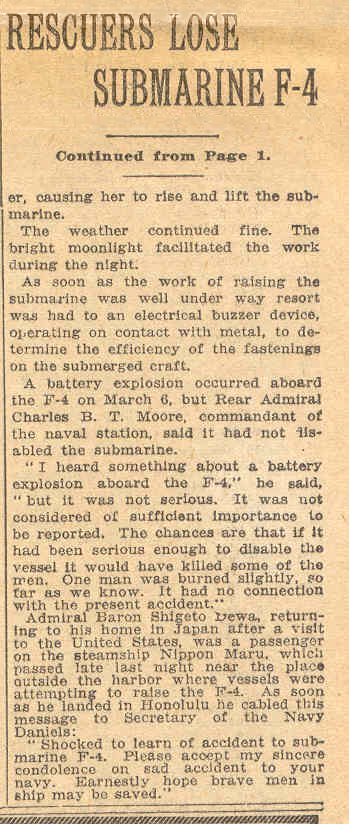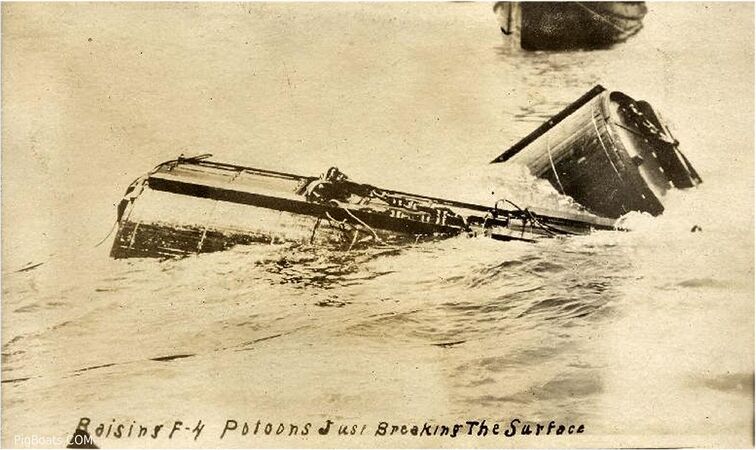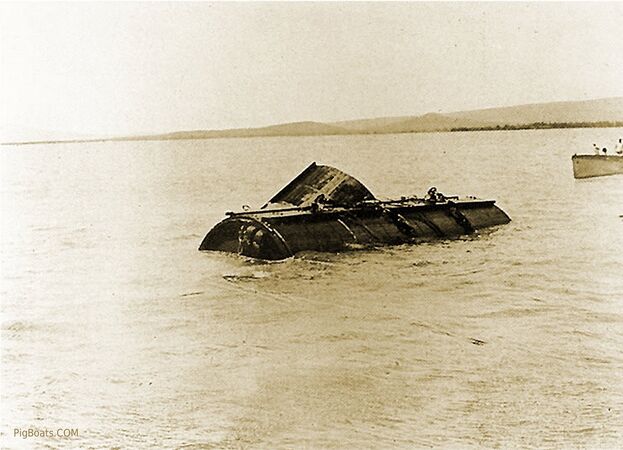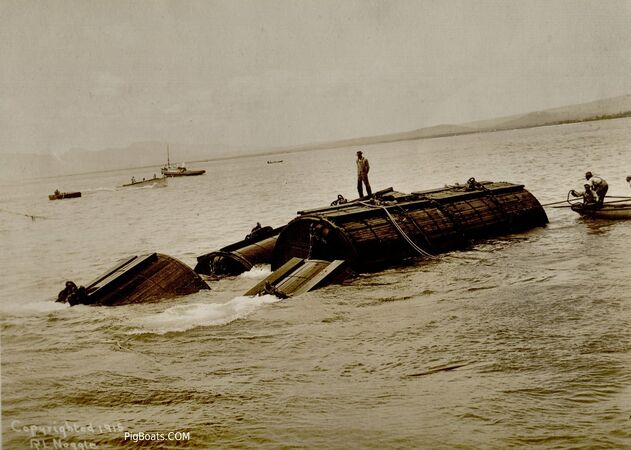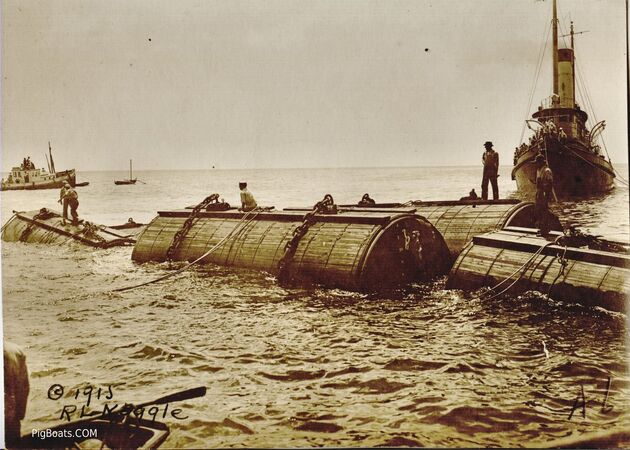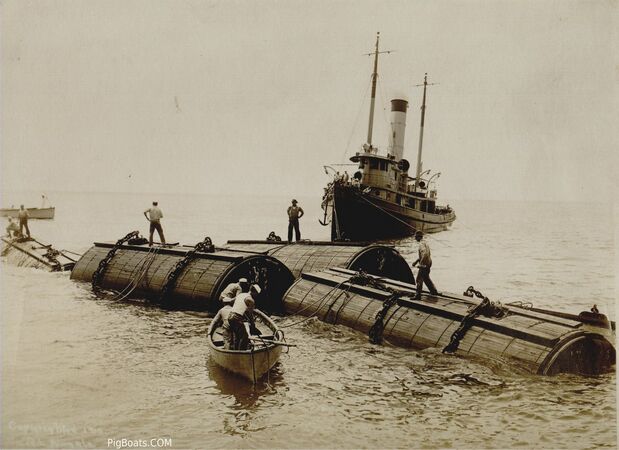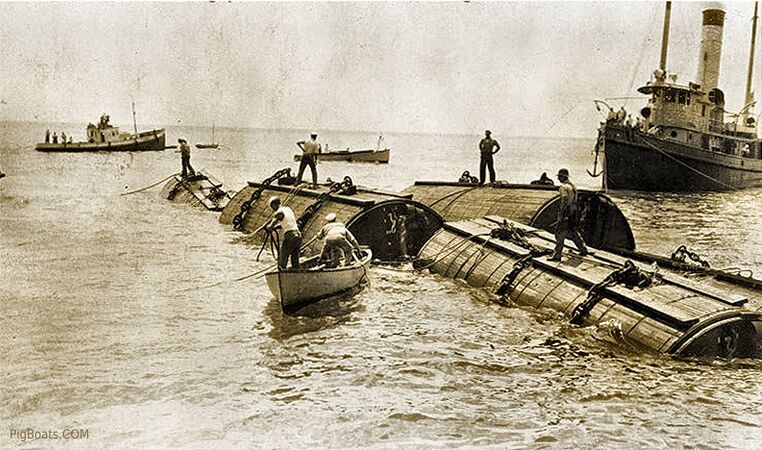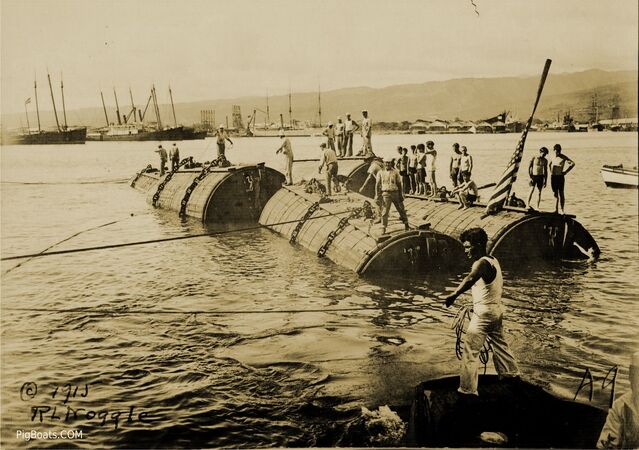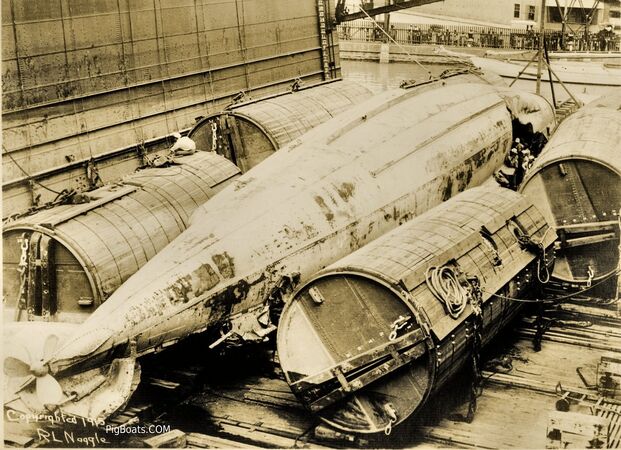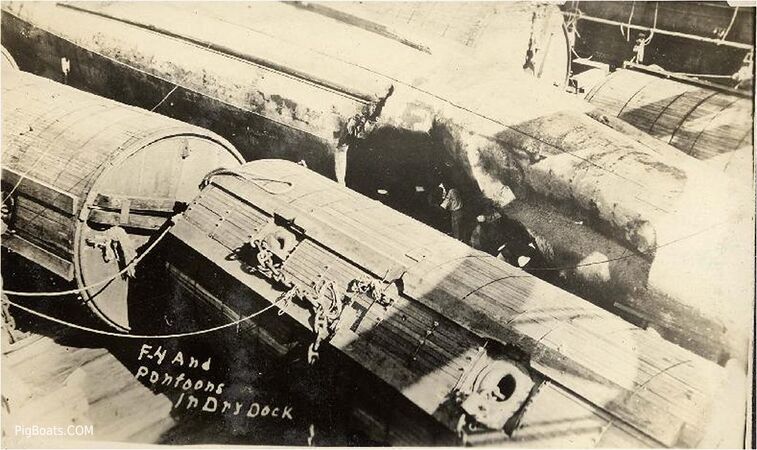F-4 salvage: Difference between revisions
Pbcjohnston (talk | contribs) Added one photo |
Pbcjohnston (talk | contribs) Added captions |
||
| Line 14: | Line 14: | ||
<div style="text-align: justify;"><span style="color:#00008B">Early in the search the Navy was using every means to locate the lost submarine. All they had to go on was some air bubbles and oil. They began dragging grapples in hopes of snagging the lost vessel. These hopes were soared when a heavy object was hooked. It turned out to be the lost three and a half ton anchor from the battleship USS Oregon (BB-03). The Oregon lost her port anchor on May 30, 1901 due to a defective link that nearly killed Chief Bosun J.E. Murphy when the link parted. Murphy was a hero in the Battle of Santiago during the Spanish-American War. | <div style="text-align: justify;"><span style="color:#00008B">Early in the search the Navy was using every means to locate the lost submarine. All they had to go on was some air bubbles and oil. They began dragging grapples in hopes of snagging the lost vessel. These hopes were soared when a heavy object was hooked. It turned out to be the lost three and a half ton anchor from the battleship USS Oregon (BB-03). The Oregon lost her port anchor on May 30, 1901 due to a defective link that nearly killed Chief Bosun J.E. Murphy when the link parted. Murphy was a hero in the Battle of Santiago during the Spanish-American War. | ||
According to the Board of Investigation Report, when | According to the Board of Investigation Report, when the anchor was discovered Jack Agraz, Chief Gunners Mate, a Navy diver from the USS F-1, donned his gear and followed the line to the target. Three crews of four men each manned the hand turned air pump supplying air to him. He discovered the grapple chain was wrapped around "an old anchor" at 215 feet. The F-4 had not been found. | ||
<small>Photo in the private collection of Ric Hedman.</small> | <small>Photo in the private collection of Ric Hedman.</small> | ||
| Line 42: | Line 42: | ||
[[File:F-4 salvage 5.jpg|left|500px]] | [[File:F-4 salvage 5.jpg|left|500px]] | ||
<div style="text-align: justify;"><span style="color:#00008B">A rather crowded diving launch hovering over the scene of F-4's sinking. Given the fact that none of the men appear to be operating the pump, it is | <div style="text-align: justify;"><span style="color:#00008B">A rather crowded diving launch hovering over the scene of F-4's sinking. Given the fact that none of the men appear to be operating the pump, it is unlikely that there is a diver in the water from this launch. The men are intently trying to peer though the water, with one man using a glass bottomed bucket to try to see better. Most of the diving on the F-4 was conducted from these launches, as there were no specialized salvage ships in Hawaii at that time. | ||
<small>Photo in the private collection of Ric Hedman.</small> | <small>Photo in the private collection of Ric Hedman.</small> | ||
| Line 52: | Line 52: | ||
<small>Photo in the private collection of Ric Hedman.</small> | <small>Photo in the private collection of Ric Hedman.</small> | ||
[[File:Red bar sub new.jpg]] | |||
<center> | |||
<gallery mode="packed" widths="600px" heights="800px"> | |||
File:F-4 newspaper article A.jpg | |||
File:F-4 newspaper article.jpg | |||
File:F-4 newspaper article C.jpg | |||
</gallery> | |||
</center> | |||
<div style="text-align: justify;"><span style="color:#00008B">This article is from the March 28, 1915 issue of The New York Times. It describes the feverish work that went on to try to raise the boat in the first few days, an ultimately vain effort to save the crew. No diver had yet actually made it to the sub, so the full extent of the damage was not known at this point. | |||
<small>Copyright The New York Times</small> | |||
[[File:Red bar sub new.jpg]] | [[File:Red bar sub new.jpg]] | ||
| Line 191: | Line 204: | ||
[[File:F-4 salvage dd 4.jpg|left|500px]] | [[File:F-4 salvage dd 4.jpg|left|500px]] | ||
<div style="text-align: justify;"><span style="color:#00008B">Once the dock was fully out of the water, the full extent of the damage to the F-4 was visible for the first time. The implosion in the started in the overhead of the torpedo room, nearing the torpedo loading hatch. It was a natural weak point in the structure where two hull plates were riveted together. The hull collapsed inward, nearly 150 psi knocking a huge hole in the pressure hull. Further collapse was stopped by the nearly instantaneous flooding of the rest of the boat. | <div style="text-align: justify;"><span style="color:#00008B">Once the dock was fully out of the water, the full extent of the damage to the F-4 was visible for the first time. The implosion in the started in the overhead of the torpedo room, nearing the torpedo loading hatch. It was a natural weak point in the structure where two hull plates were riveted together. The hull collapsed inward, the nearly 150 psi of water pressure knocking a huge hole in the pressure hull. Further collapse was stopped only by the nearly instantaneous flooding of the rest of the boat. | ||
In this view the boat is upside down, with the port side facing up, looking at the bow. The strake like object at the top is the port side bilge keel, with the main keel just to the right of that. It is important to understand that the leaking battery acid did not cause the implosion. The battery acid weakened the bottom of the hull structure, causing a leak which made the boat heavy, quickly resulting in a loss of control. It was when the boat exceeded crush depth that the hull imploded. | In this view the boat is upside down, with the port side facing up, looking at the bow. The strake like object at the top is the port side bilge keel, with the main keel just to the right of that. It is important to understand that the leaking battery acid did not cause the implosion. The battery acid weakened the bottom of the hull structure, causing a leak which made the boat heavy, quickly resulting in a loss of control. It was when the boat exceeded crush depth that the hull imploded. | ||
| Line 261: | Line 274: | ||
This photo shows the F-4 with her bow cap rotated to line up with two of her four torpedo tubes. This was done so that the weapons in the tubes could be removed. To access the other two tubes the cap was rotated to the right. To completely close all four tubes the cap was rotated so that the openings were vertical and behind the stem. | This photo shows the F-4 with her bow cap rotated to line up with two of her four torpedo tubes. This was done so that the weapons in the tubes could be removed. To access the other two tubes the cap was rotated to the right. To completely close all four tubes the cap was rotated so that the openings were vertical and behind the stem. | ||
<small>Photo in the private collection of Ric Hedman.</small> | |||
[[File:Red bar sub new.jpg]] | |||
[[File:F-4 salvage battery.jpg|left|500px]] | |||
<div style="text-align: justify;"><span style="color:#00008B">An interior photo taken after salvage showing the battery plates falling out of the battery. Plates were positioned in the battery box and held in place the proper distance with small precisely made wooded wedges. When the vessel was turned over the weight of the lead plates against the wooden decking covering the battery was too much and the planks were ripped off the top of the battery well. Being underwater the sulfuric acid mixed with the salt water and escaped as a cloud of bubbles. | |||
<small>Photo in the private collection of Ric Hedman.</small> | |||
[[File:Red bar sub new.jpg]] | |||
[[File:F-4 salvage engine room door.jpg|left|500px]] | |||
<div style="text-align: justify;"><span style="color:#00008B">This view is in the control room, looking aft at the bulkhead that divides it from the engine room. The empty cells of the after battery well are visible in the upper right. The door was ripped apart when it imploded into the engine room. As the boat was sinking, many of the crew sought refuge in the engine room in a vain attempt to save their lives. It may have also been an attempt to move weight aft to counteract the effect of flooding in the forward battery well. At any rate, the door did not hold for long after the torpedo room implosion, collapsing a few seconds later, killing the remainder of the crew. | |||
<small>Photo in the private collection of Ric Hedman.</small> | <small>Photo in the private collection of Ric Hedman.</small> | ||
| Line 272: | Line 299: | ||
[[File:F-4 hoggett.jpg|left|500px]] | [[File:F-4 hoggett.jpg|left|500px]] | ||
<div style="text-align: justify;"><span style="color:#00008B">James Morton Hoggett, Electricians Mate Third Class, was the only member of the F-4 crew to not die that fateful day. | |||
On March 25, 1915 he was left ashore when the F-4 went out on her fateful morning dive. It was a habit for the early submarines to leave one man ashore as a watchman, perhaps to keep an eye on ships material left on the dock and to be a contact person for any information that needs to be reported to the vessel as soon as it returns to port. This was the days before ship radios became common. It happened to be his turn this day. | |||
In most all of the the news reports after the sinking reported he was on 'shore leave' at the time instead of being the "watchman". There was one other man who escaped the sinking, Artheur Mellien, a Chief Machinist Mate, who transferred off the F-4 a few days prior to the sinking. | |||
In the aftermath of the sinking, Hoggett seems to have developed symptoms of PTSD. Accounts of his doings and happenings after the sinking show he seems to have become fairly reckless in his activities and had a number of close to death encounters. Of course nothing was known about PTSD at that time. | |||
He left the Navy in 1916 and when WWI came around he enlisted in the Army Tank Corp in 1918. He survived the war. | |||
James Hoggett died May 31, 1952 in Rolla, MO. He had served on the USS Pensacola, Pittsburgh, Oregon, Maryland, Pennsylvania, the Alert, (a submarine tender), the F-4 and the USS Constellation before being discharged. He was a lucky person to have lived out a normal life span that his shipmates on the F-4 were denied. | |||
<small>Photo in the private collection of Ric Hedman.</small> | |||
[[File:Red bar sub new.jpg]] | |||
[[File:F-4 auto blow system.jpg|left|500px]] | [[File:F-4 auto blow system.jpg|left|500px]] | ||
<div style="text-align: justify;"><span style="color:#00008B">The F-class submarines had an automatic ballast tank blowing system set to send the submarine to the surface if the sub descended below 100 feet. It was determined by the commission that investigated the sinking that the initial casualty happened above 100 feet. This system was euphemistically referred to as the "plow". | |||
The drawing above was made of the F-4 Automatic Blow System after recovery. It shows the setup and condition of the system made by the crew at the time of the disaster. Short of actually being able to talk to the crew it shows the steps they had taken in the few moments available to them. | |||
This system is something akin to today's Emergency Blow system brought about by the sinking of the USS Thresher (SSN-593) in 1963, although the F-4's system was automatic, whereas the modern system must be manually actuated. | |||
<small>Image from the National Archives.</small> | |||
[[File:Red bar sub new.jpg]] | [[File:Red bar sub new.jpg]] | ||
[[File:F-4 newspaper article 2.jpg|left|500px]] | |||
<div style="text-align: justify;"><span style="color:#00008B">Navy personnel quickly removed the bodies of the crew, and investigators swarmed the wreck, gathering data to use in the investigation. F-4 was also stripped of any equipment useful to the other F-boats. The Navy was under a time crunch, as they had to vacate the drydock in order to let the tug that was in the dock behind the sub out once its repairs were complete. On the evening of September 14, 1915 she was refloated once again, suspended from her pontoons. The tug Navajo towed her up the coast to Pearl Harbor. Navajo took her to what was then a backwater section of the harbor called Magazine Loch. She towed F-4 into the loch until she grounded in the soft mud. She was left there until the investigation was complete. The Navy dithered as to what to do with the sub, so it was decided to just leave her where she sat. On November 25 the pontoon chains were cast loose and the F-4 was allowed to settle into the soft mud of the bottom of the loch. | |||
File:F-4 newspaper article | |||
She is still there to this day. In 1940 she was rolled into a trench dredged in the loch bottom to make way for the expansion of docks at the submarine base. She sits at an angle of 43.5 degrees true about 40 feet off the Sierra 13 mooring. About parallel to the old shore line (see below). | |||
<small>Clipping courtesy of the Honolulu Star-Bulletin.</small> | |||
<div style="text-align: justify;"><span style="color:#00008B"> | |||
[[File:Red bar sub new.jpg]] | [[File:Red bar sub new.jpg]] | ||
[[File:F-4 resting spot.jpg|left|500px]] | [[File:F-4 resting spot.jpg|left|500px]] | ||
<div style="text-align: justify;"><span style="color:#00008B">The location circled above is the approximate location for the ex-USS F-4's hull. The unfinished nature of the Submarine Base is visible in this photo from the late 1920's showing the future area of expansion that will involve the hulk of the F-4. The two S-class submarines are moored to the "Sierra 12" mooring. | |||
Note in the background that at this point that only a narrow causeway connects the main part of the Submarine Base to Kuahua. As the base rapidly expanded in the 1930's and 1940's this area would be completely filled in and Kuahua would no longer be an islet. | |||
<small>National Archives photo.</small> | |||
[[File:Red bar sub new.jpg]] | |||
[[File:F-4 chart.jpg|left|500px]] | [[File:F-4 chart.jpg|left|500px]] | ||
<div style="text-align: justify;"><span style="color:#00008B">A page from a Navy publication of the late 1920's. This is of Magazine Loch and shows water depths in preparation for the expansion of the Submarine Base northeastward. Drawn in is the location of the F-4 hull as it laid at the time of disposal on the loch floor. The numbers show how deep the loch was at that time. The depths are in feet. It was determined that F-4 was in the way of the pier expansion plans so a trench was dredged just to the left of her and the wreck was pushed into it. This made the wreck deep enough that it would not interfere with anything above. | |||
<small>Photo in the private collection of Ric Hedman.</small> | |||
[[File:Red bar sub new.jpg]] | |||
[[File:F-4 Magazine Loch snip.jpg|left|500px]] | [[File:F-4 Magazine Loch snip.jpg|left|500px]] | ||
<div style="text-align: justify;"><span style="color:#00008B">A snip from MS Maps showing the present day configuration of Magazine Loch. The F-4's hull sits in a trench directly below where the small tug pushing the barge is, right at the end of the right hand pier. | |||
[[File:Red bar sub new.jpg]] | [[File:Red bar sub new.jpg]] | ||
<div style="text-align: justify;"><span style="color:#000000"> | |||
=== <big>F-4 Legacy</big> === | === <big>F-4 Legacy</big> === | ||
</div> | |||
[[File:F-4 funeral 1.jpg|left|500px]] | [[File:F-4 funeral 1.jpg|left|500px]] | ||
Revision as of 21:37, 8 September 2023
Search for the Lost Boat
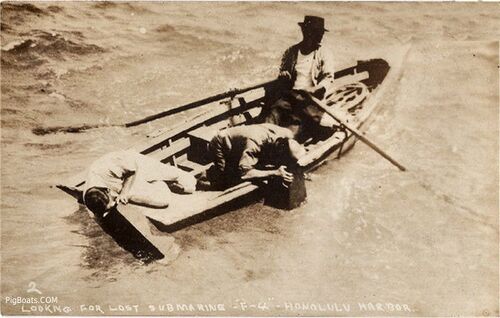
Here two men are using a box with a glass plate in the bottom that allowed a clearer view of things underwater.
Photo in the private collection of Ric Hedman.
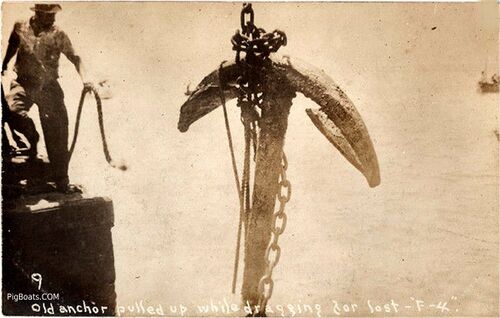
According to the Board of Investigation Report, when the anchor was discovered Jack Agraz, Chief Gunners Mate, a Navy diver from the USS F-1, donned his gear and followed the line to the target. Three crews of four men each manned the hand turned air pump supplying air to him. He discovered the grapple chain was wrapped around "an old anchor" at 215 feet. The F-4 had not been found.
Photo in the private collection of Ric Hedman.

Photo in the private collection of Ric Hedman.

Photo in the private collection of Ric Hedman.
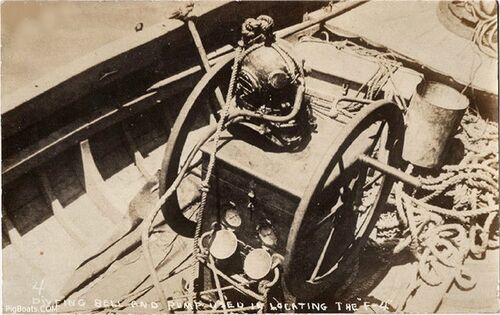
Photo in the private collection of Ric Hedman.
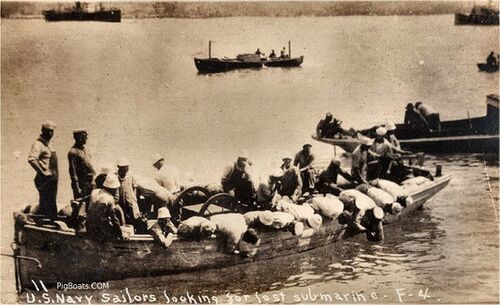
Photo in the private collection of Ric Hedman.

Photo in the private collection of Ric Hedman.
Copyright The New York Times
Salvage Work

Photo in the private collection of Ric Hedman.
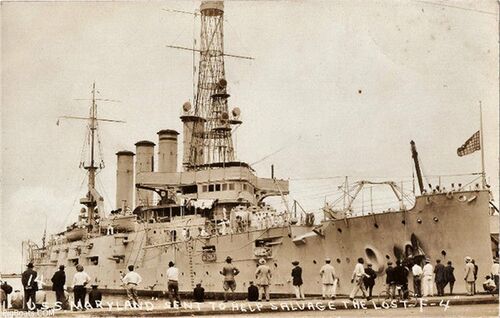
Photo in the private collection of Ric Hedman.

Photo in the private collection of Ric Hedman.
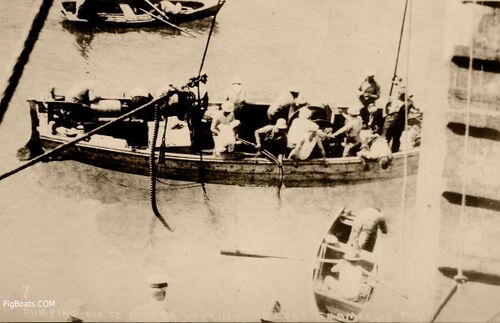
Photo in the private collection of Ric Hedman.
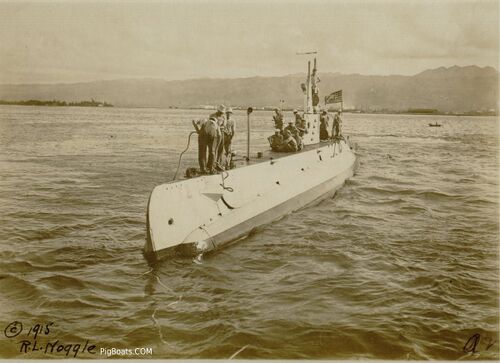
The rope that is being worked on by the men on deck can be seen floating in the water in front of the submarine. There is a similar one stretching from the after deck to what is assumed to be the salvage barge. The F-2 is probably in the process of mooring to that barge to supply the air needed for the pontoons.
Note the proximity to the shore. The F-4 sank just outside of the entrance to Honolulu Harbor, in Mamala Bay. With Oahu essentially being the top of an underwater mountain, the water depth drops off precipitously as soon as you leave the harbor.
Photo in the private collection of Ric Hedman.
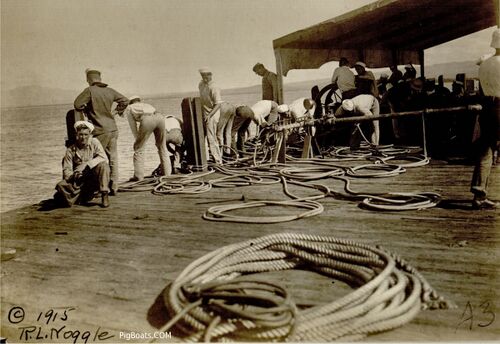
Photo in the private collection of Ric Hedman.
Raising the Boat with Pontoons
Photos in the private collection of Ric Hedman.

In the center background is the Navy floating cantilever pontoon crane YD-25. The crane had a lifting rating of 150 tons. Too little to have lifted the flooded F-4. She was destined to become a visual fixture at Pearl Harbor for the next dozen years.
In the left background the USS Maryland is moored. She is the vessel that brought the six lifting pontoons to Hawaii.
Newspaper photo.

Photo in the private collection of Ric Hedman.
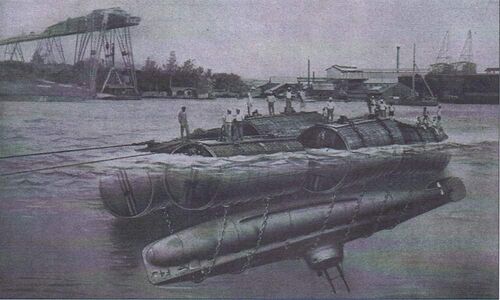
Photo from Beneath the Surface: WWI Submarines Built in Seattle and Vancouver by Bill LIghtfoot.
Photos in the private collection of Ric Hedman.
In Drydock

Newspaper photo.

Photo in the private collection of Ric Hedman.
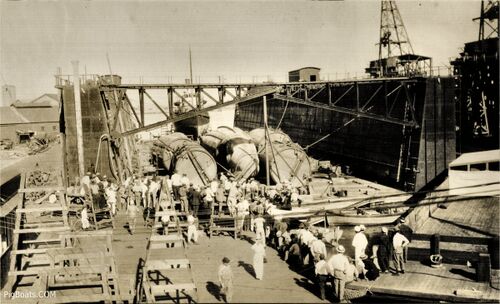
Photo in the private collection of Ric Hedman.
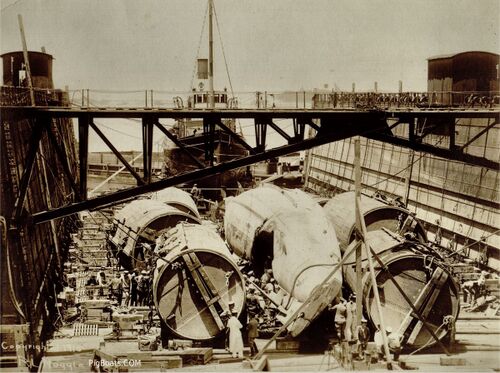
In this view the boat is upside down, with the port side facing up, looking at the bow. The strake like object at the top is the port side bilge keel, with the main keel just to the right of that. It is important to understand that the leaking battery acid did not cause the implosion. The battery acid weakened the bottom of the hull structure, causing a leak which made the boat heavy, quickly resulting in a loss of control. It was when the boat exceeded crush depth that the hull imploded.
Admiral Clifford J. Boush, Commandant of the 14th Naval District in Hawaii, is seen in the foreground, wearing the long white coat.
Photo in the private collection of Ric Hedman.
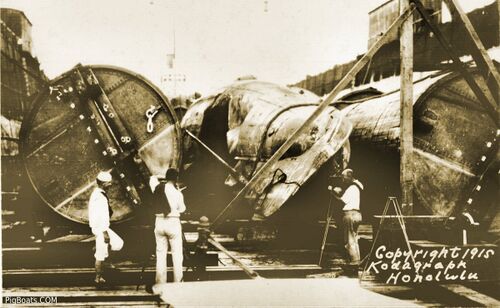
Photo in the private collection of Ric Hedman.
-
Photo in the private collection of Ric Hedman.
-
Photo courtesy of Mike Dilley, whose father, Homer 'Pat' Dilley, sailed aboard the USS F-2.
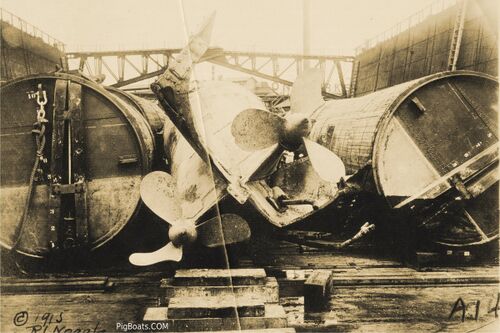
These newly installed experimental propellers were of a special design that were intended for low RPM and high efficiency. It is thought that at high speeds they would have done little to drive the submarine to the surface. The official report stated that these propellers "were the secondary cause of the disaster" by providing insufficient water flow over the stern planes and thus negatively impacting the control of the vessel.
Photo in the private collection of Ric Hedman.

The extensive damage to the after end of the submarine is very evident. Remembering that the submarine is almost upside down, the twisted piece of metal to the left and twisted towards the camera is actually part of the upper skeg running from the deck to the rudder. It has been bent over more than 90 degrees. The blades of the screws have been bent over and a huge chip has been made in the blade of the screw.
Photo in the private collection of Ric Hedman.
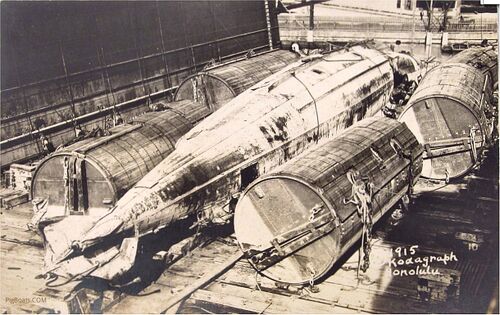
Photo in the private collection of Ric Hedman.

Photo in the private collection of Ric Hedman.
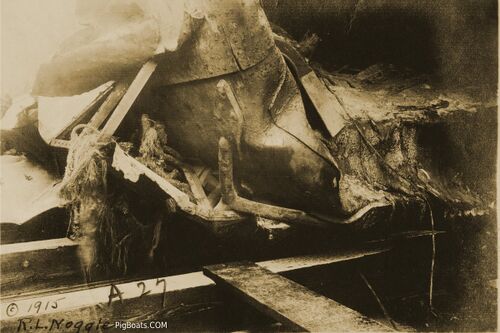
Photo in the private collection of Ric Hedman.

This photo shows the F-4 with her bow cap rotated to line up with two of her four torpedo tubes. This was done so that the weapons in the tubes could be removed. To access the other two tubes the cap was rotated to the right. To completely close all four tubes the cap was rotated so that the openings were vertical and behind the stem.
Photo in the private collection of Ric Hedman.
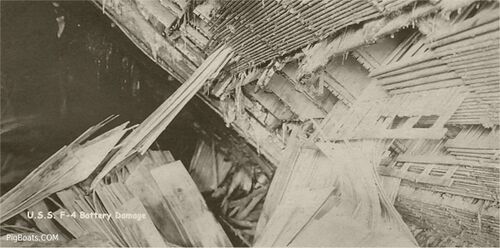
Photo in the private collection of Ric Hedman.
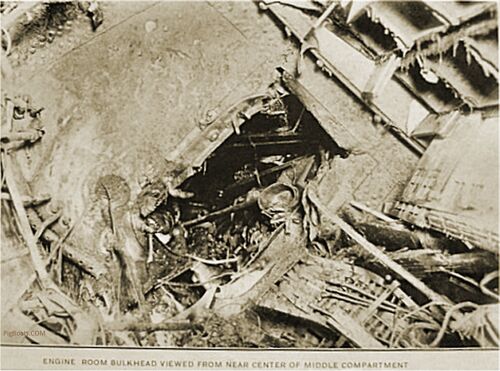
Photo in the private collection of Ric Hedman.
Post Salvage
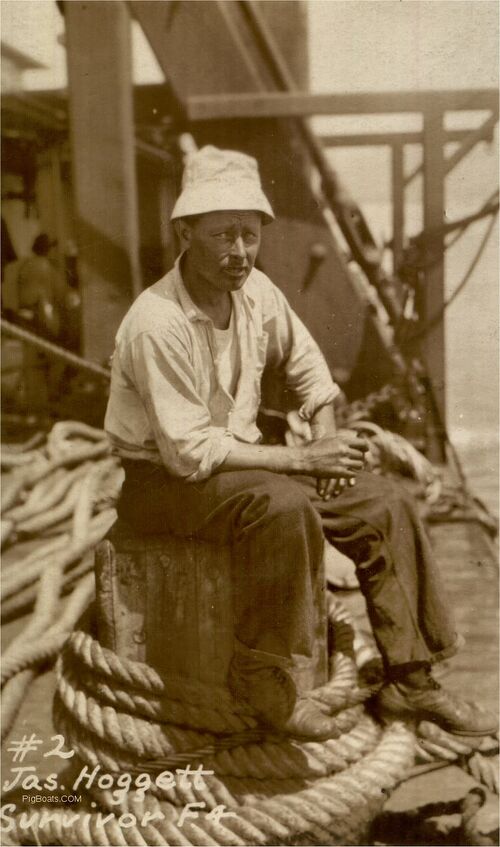
On March 25, 1915 he was left ashore when the F-4 went out on her fateful morning dive. It was a habit for the early submarines to leave one man ashore as a watchman, perhaps to keep an eye on ships material left on the dock and to be a contact person for any information that needs to be reported to the vessel as soon as it returns to port. This was the days before ship radios became common. It happened to be his turn this day.
In most all of the the news reports after the sinking reported he was on 'shore leave' at the time instead of being the "watchman". There was one other man who escaped the sinking, Artheur Mellien, a Chief Machinist Mate, who transferred off the F-4 a few days prior to the sinking.
In the aftermath of the sinking, Hoggett seems to have developed symptoms of PTSD. Accounts of his doings and happenings after the sinking show he seems to have become fairly reckless in his activities and had a number of close to death encounters. Of course nothing was known about PTSD at that time.
He left the Navy in 1916 and when WWI came around he enlisted in the Army Tank Corp in 1918. He survived the war.
James Hoggett died May 31, 1952 in Rolla, MO. He had served on the USS Pensacola, Pittsburgh, Oregon, Maryland, Pennsylvania, the Alert, (a submarine tender), the F-4 and the USS Constellation before being discharged. He was a lucky person to have lived out a normal life span that his shipmates on the F-4 were denied.
Photo in the private collection of Ric Hedman.

The drawing above was made of the F-4 Automatic Blow System after recovery. It shows the setup and condition of the system made by the crew at the time of the disaster. Short of actually being able to talk to the crew it shows the steps they had taken in the few moments available to them.
This system is something akin to today's Emergency Blow system brought about by the sinking of the USS Thresher (SSN-593) in 1963, although the F-4's system was automatic, whereas the modern system must be manually actuated.
Image from the National Archives.
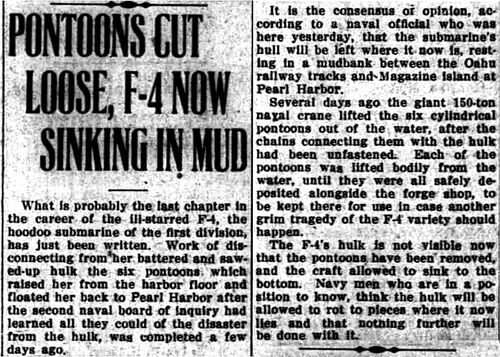
She is still there to this day. In 1940 she was rolled into a trench dredged in the loch bottom to make way for the expansion of docks at the submarine base. She sits at an angle of 43.5 degrees true about 40 feet off the Sierra 13 mooring. About parallel to the old shore line (see below).
Clipping courtesy of the Honolulu Star-Bulletin.
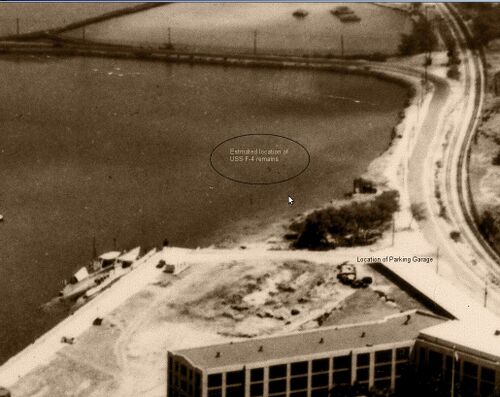
Note in the background that at this point that only a narrow causeway connects the main part of the Submarine Base to Kuahua. As the base rapidly expanded in the 1930's and 1940's this area would be completely filled in and Kuahua would no longer be an islet.
National Archives photo.
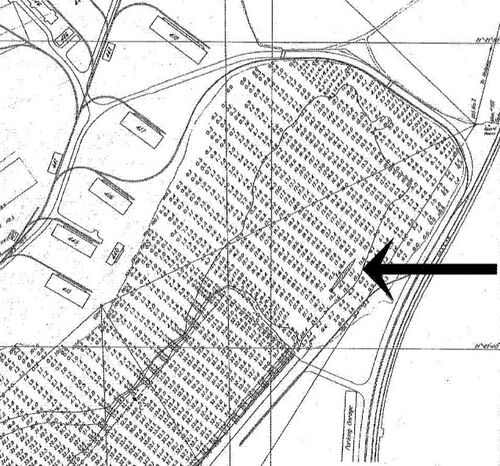
Photo in the private collection of Ric Hedman.
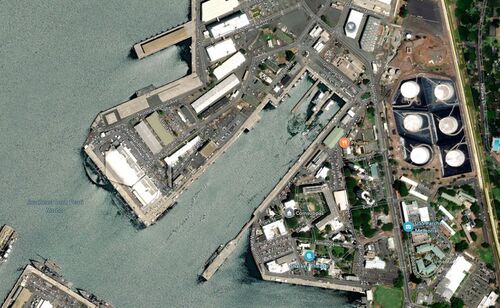
F-4 Legacy
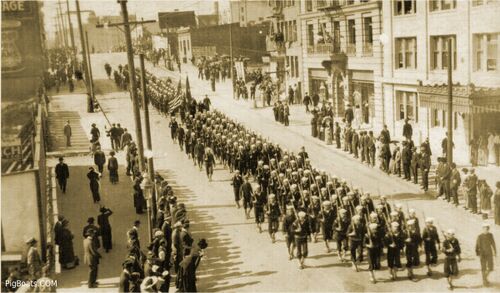



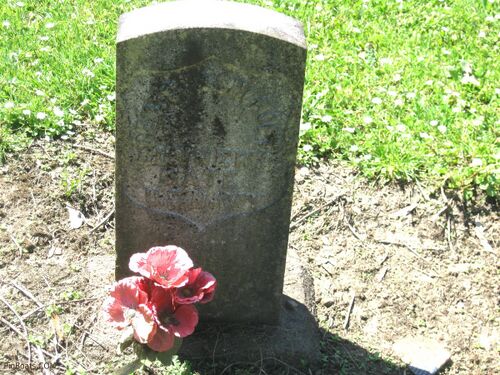
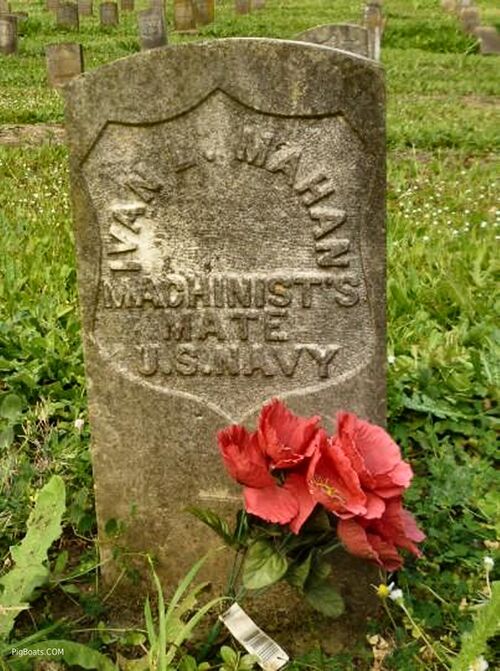
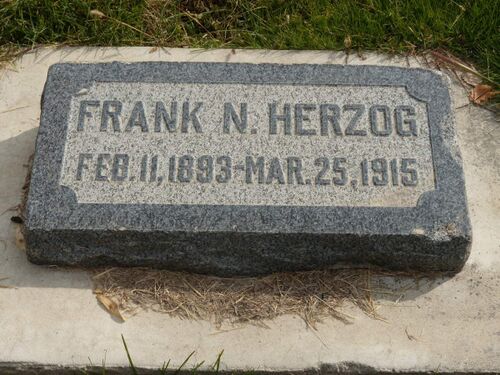
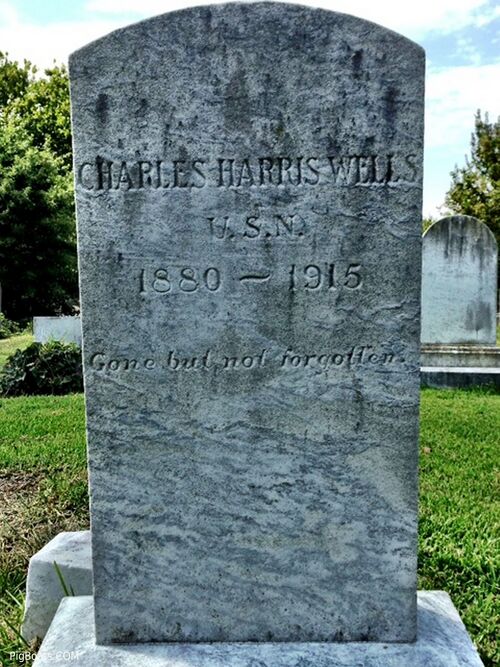
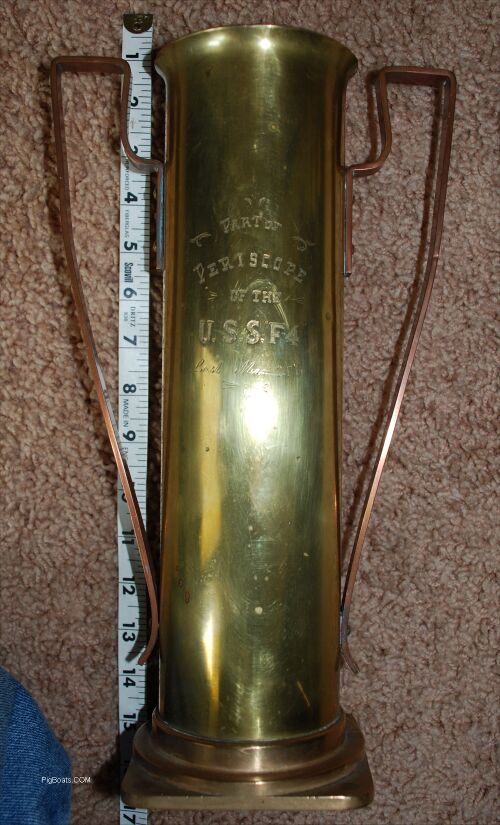
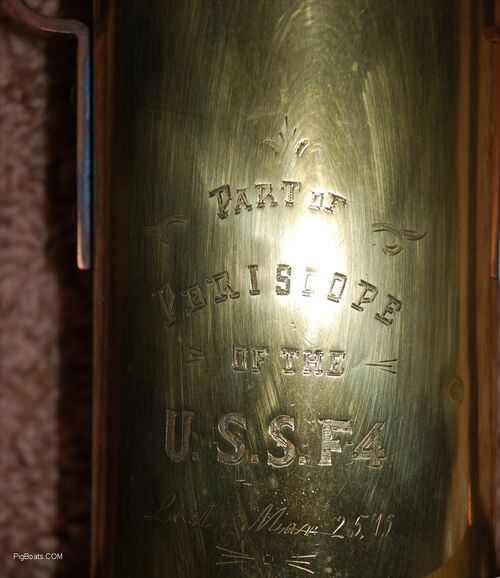
Page created by:
Ric Hedman & David Johnston
1999 - 2023 - PigBoats.COM©
Mountlake Terrace, WA, Norfolk, VA
webmaster at pigboats dot com



